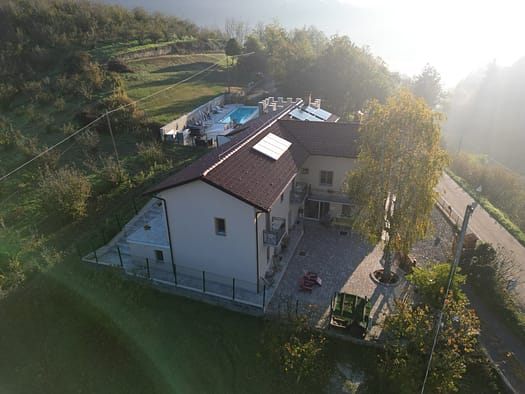Our epicurean ensemble, spirits high and palates primed, we bade farewell to the romantic realms of Valpolicella, a veritable garden where Bacchus himself would have reveled in ruby red rapture. Our compass pivoted east, and the lure of Piedmont’s liquid treasures steered us through the undulating embrace of Northern Italy’s winelands.
Descending from the autostrade at Asti, we entered Barbera’s dominion, the vineyards unfurling like green and gold scrolls penned by the gods of the vine. Our destination was the idyllic Villa Alta Langa in Cravanzana, a name that rolls off the tongue as smoothly as the wines it promised.

The Welcome: A Warm Embrace by Villa Alta Langa
Our arrival at Villa Alta Langa was an affair of familial warmth. Hugo and Pietra, custodians of this rural repose, greeted us not as guests but as kin returned from afar. A lunch of Piedmontese splendor awaited, where simple ingredients spoke of the land’s fecundity, each flavor a narrative of nurture.

The Truffle’s Allure
The highlight of the evening was a feast under the firmament, a starlit symphony of tastes and tales. Truffles, Piedmont’s black diamonds, freshly harvested by a neighbor of our hosts, were shaved with a ceremonial reverence over dishes that would haunt our memories forever. The farmer who generously provided the coveted fresh truffles, a man whose very hands told of toil and terroir, joined us, bridging the gap between earth and table with his prized fungi.
The Wines: Ambassadors of Piedmont
The wines, ah, the wines. As the evening progressed, we poured the essence of Piedmont into our glasses. The Barolo, with its garnet glow, brought forth a historical tapestry, each sip a thread connecting past and present. The Dolcetto, a touch more demure, whispered of fog-laden mornings and the sweet ache of anticipation.

The conversation, lubricated by these vinous voices, danced across subjects as diverse as the wines themselves. From the nebbiolo’s nuanced tales to the Dolcetto’s jovial jests, we traversed the spectrum of Piedmont’s enological expressions.
As the night waned, we plotted our forthcoming days. Piedmont promised more than just gustatory delights; it was a living museum of viticulture, each winery a gallery, each vintage a masterpiece waiting to be discovered.
We would wander through cellars where the patina of age hung as thick as the aroma of oak, visit estates where innovation walked hand-in-hand with tradition, and perhaps most enchantingly, meet the vintners—the true artists of the soil.
Conclusion: Piedmont’s Ode to Joy
Our initial foray into Piedmont’s vinous verse was merely the prelude to what we knew would be an odyssey of senses. We looked forward to days filled with the discovery of the deeper secrets of these incredible varietals.
We retired to our rooms, heads spinning not from the wine but from the intoxicating prospect of the days ahead. In Piedmont, every hillside seemed to hold a secret, every vine a story, and every glass poured promised a journey not just across palates but through time and tradition.
As I closed my eyes, it was with the knowledge that we were not merely traveling through Piedmont—we were immersing ourselves in a region where the wine is the ink with which its story is written, an epic still unfolding with each vintage, every glass, a new chapter in Italy’s enduring love affair with the vine.
��
